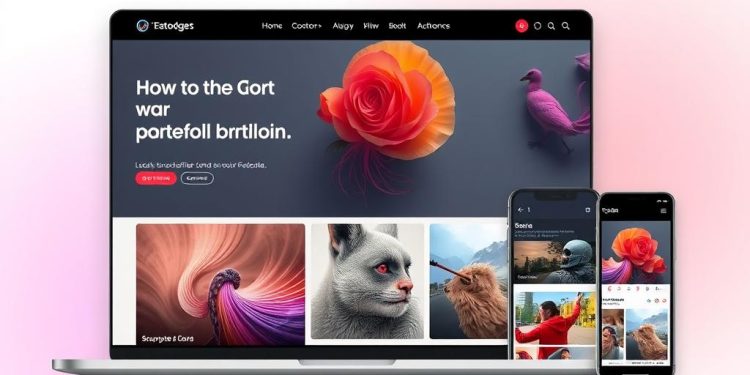Creating an online portfolio is a fundamental step in enhancing your professional presence and attracting prospective clients. Your portfolio is more than just a collection of your work; it’s a reflection of your identity, creativity, and expertise in your field. In today’s competitive landscape, it’s crucial to understand that portfolio building is not just beneficial but essential for client acquisition.
Did you know that 63% of hiring decisions are swayed by the quality of a creative professional’s portfolio? As most job seekers miss the mark by not having a personal website, it’s clear that having an online portfolio can set you apart from the crowd. In a world where clients sift through hundreds of applications daily, a well-structured and visually appealing portfolio can significantly enhance your chances of catching their eye.
In this article, we’ll delve into effective strategies and best practices that will help you develop an engaging and dynamic portfolio. From showcasing your finest work to maintaining easy navigation, every detail matters in ensuring your client acquisition efforts are successful. Get ready to transform your digital presence!
Understanding the Importance of Your Online Portfolio
Your online portfolio represents more than just a collection of your work; it is your most valuable asset in the realm of client acquisition. This digital showcase allows potential clients to assess your capabilities and creativity effectively. Investing time and effort in developing your portfolio can significantly influence hiring decisions, showcasing your unique skills and style that set you apart from the competition.
Why Your Portfolio Is Your Best Asset
Statistics reveal that 58% of freelancers maintain an online portfolio. This demonstrates a growing recognition of portfolios as essential tools for client engagement. Almost 100% of modern jobs involve some online component, solidifying the importance of an engaging online presence. For freelancers, 48% report finding clients through their portfolios, emphasizing the direct link between a well-crafted portfolio and successful client acquisition. Furthermore, linking your online portfolio in your resume offers hiring managers a convenient way to evaluate your work before interviews.
Statistics That Emphasize Portfolio Impact
The relevance of a creative portfolio extends beyond mere aesthetics. Research indicates that employers now prioritize demonstrable skills and solid evidence of contributions over conventional job descriptions. Nearly 91% of freelancers find work via referrals, suggesting that having a strong online showcase can enhance word-of-mouth recommendations. It is apparent that a compelling portfolio not only captures attention but serves as a marketing tool to extend professional relationships.
Started Building Your Online Presence
As you contemplate your online portfolio, consider how essential it has become in various career fields, not solely in creative industries. Platforms for creating customizable, dynamic portfolios are widely available and often free, enabling you to personalize your digital presence. Students are increasingly starting to build their personal online portfolios during their college years, reflecting a trend toward a digital-first approach in job applications. A well-maintained portfolio can effectively communicate your personal branding, hold your work narratives, and enhance your professional appeal.
| Statistic | Impact |
|---|---|
| 58% of freelancers have an online portfolio | Shows growing importance of digital presence |
| 48% of freelancers find clients via their portfolio | Highlights portfolio’s role in client acquisition |
| 91% of freelancers rely on referrals | Reinforces need for a strong online showcase |
| Almost 100% of jobs have an online component | Indicates necessity for a professional online presence |
| Students increasingly building portfolios | Reflects the shift toward a digital-first approach |
Key Elements of Effective Portfolio Building
Creating a compelling online portfolio involves several key elements that enhance your ability to attract potential clients. Focusing on showcasing your best work ensures that your creative skills showcase stands out. Prioritizing quality over quantity helps highlight projects that demonstrate your capabilities. A well-structured portfolio not only organizes your projects but also emphasizes a seamless navigation experience.
Showcasing Your Best Work
Developing an effective portfolio requires a careful selection of your best work. Aim to include only about 10-20% of standout pieces to maintain a strong impact. A curated display draws attention to what sets you apart from competitors. Incorporate engaging captions to provide context and telling stories behind each project. Studies indicate that this approach can elevate user engagement significantly.
Diverse Project Types to Attract Varied Clients
Aiming for diversity is crucial when presenting your work. Including a variety of project types showcases versatility and adaptability, appealing to varied clients across different industries. This can involve presenting both personal and professional projects to indicate your range as a creative. An organized display allows potential clients to quickly assess your capacity to meet diverse needs.
Highlight Your Unique Style and Personal Branding
Personal branding plays a vital role in distinguishing your portfolio. Define your unique value proposition (UVP) and ensure it resonates throughout your layout. A cohesive visual identity reinforces your professional appearance, making you memorable to clients. Studies show that 70% of consumers prefer engaging with well-designed sites. This highlights the importance of a visually appealing portfolio that reflects your unique style while fostering an emotional connection with clients.
| Element | Importance | Best Practice |
|---|---|---|
| Showcasing Best Work | Attracts attention | Limit to 10-20% of best projects |
| Diverse Project Types | Appeals to varied clients | Include personal and professional work |
| Unique Style | Enhances personal branding | Consistent visual identity |
Strategies for Online Portfolio Creation
Creating an impressive online portfolio requires careful planning and implementation of strategies that enhance your online presence and attract potential clients. A well-crafted portfolio not only showcases your skills but also ensures you are visible in competitive markets. Below are key strategies to help you maximize your online portfolio creation.
Choose the Right Platform for Your Portfolio
Selecting the right platform to host your portfolio is fundamental. User-friendly options like Squarespace or Pagecloud allow for easy customization and are ideal for those without technical skills. Consider which platform best suits your specific needs, whether it’s a visually appealing design portfolio or a clear product showcase. A professional representation will significantly impact viewer engagement.
Utilize SEO to Increase Visibility
Implementing effective SEO strategies can markedly enhance your portfolio’s visibility in search engines. Focus on both on-site and off-site SEO tactics. Key points to consider include:
- Optimizing site speed and mobile-friendliness.
- Using appropriate title tags and keywords relevant to your skills and services.
- Regularly updating content to reflect your latest work.
By enhancing these aspects, your portfolio becomes more discoverable by potential clients searching for the expertise you provide.
Include Client Testimonials for Social Proof
Incorporating client testimonials adds credibility to your online presence. Social proof, in the form of reviews and recommendations, can influence potential clients’ decision-making. Cultivating good relationships with past clients is beneficial. Encouraging feedback not only boosts your portfolio’s effectiveness but also highlights the positive experiences others have had working with you.
How to Keep Your Portfolio Engaging and Dynamic
Maintaining an engaging portfolio ensures that your work remains relevant and appealing to potential clients. Regular updates are essential for showcasing your skills and demonstrating growth in your field. An engaging portfolio tells a story, while dynamic updates highlight your commitment to continuous improvement.
Regularly Update Your Work and Achievements
A consistently updated portfolio reflects your evolving capabilities. By incorporating new projects and achievements, you showcase your current skills. Consider these engaging strategies:
- Highlight new projects to showcase your latest work.
- Share successes and milestones to keep visitors informed.
- Utilize various media formats to maintain visual interest.
Show Process and Impact through Case Studies
Case studies serve as a valuable addition to your portfolio. They allow you to show the process behind your work and the impact of your projects. Outlining challenges faced, solutions implemented, and results achieved enhances the narrative quality. Incorporating visuals such as sketches and wireframes can engage viewers while effectively communicating your design process.
| Case Study Element | Importance |
|---|---|
| Challenges Faced | Illustrates problem-solving skills |
| Solutions Implemented | Demonstrates creativity and adaptability |
| Results Achieved | Highlights effectiveness and impact |
| Visual Elements | Captivates audience and clarifies information |
Network to Expand Your Reach and Opportunities
Building a strong professional network is crucial for increasing the visibility of your engaging portfolio. Attend industry events, participate in online communities, and interact genuinely with peers to establish valuable relationships. Networking not only opens doors to potential client referrals but also allows you to share knowledge and experiences that can enrich your skill set.
Conclusion
Building an impactful online portfolio is not a one-time task but a continuous journey that can dramatically enhance your client attraction efforts. By focusing on showcasing your best work and employing effective strategies such as client testimonials and a polished “About Me” page, you can create a compelling digital presence that resonates with visitors. Remember that first impressions count; many professionals struggle with self-promotion, which means you have an opportunity to stand out.
Regularly updating your portfolio helps maintain engagement and relevance, as hiring managers are often quick to judge portfolios within mere seconds. A clean layout with only your best samples—ideally not more than eight—will not only help reduce bounce rates, but also enhance the likelihood of attracting the right clients. Demonstrating your impact, through metrics or case studies, adds a layer of professionalism and credibility that can ultimately set you apart in a competitive market.
As you refine your online portfolio creation, keep in mind that personalization and clear narratives can help connect you with potential clients. Invest the time to ensure your portfolio accurately reflects your skills and achievements. By implementing these strategies and taking the necessary steps today, you can build a portfolio that captures attention and drives client inquiries.










